Resources
Crucial Considerations in Wild Animal Suffering
Crucial Considerations in Wild Animal Suffering
Jun 8, 2018
In this talk from EA Global 2018: San Francisco, Persis Eskander explores the most important questions in wild animal suffering, how to approach them, and how different answers might motivate our priorities. This is a transcript of Persis's talk, and her answers to questions from the audience, which we have lightly edited for readability.
The Talk
I'm always excited to see people interested in learning more about wild animal suffering. This talk presumes a basic understanding of the problem: I'm not really going to go into any introductory content. What I want to do with this talk is discuss the sorts of questions that we might want to be asking to understand whether we should prioritize wild animal suffering, and also what sorts of interventions we should be pursuing. So I'll go through those in the beginning, and then I'm going to look in detail at two crucial considerations, and draw out the implications that they have for the cause area.
Crucial Considerations
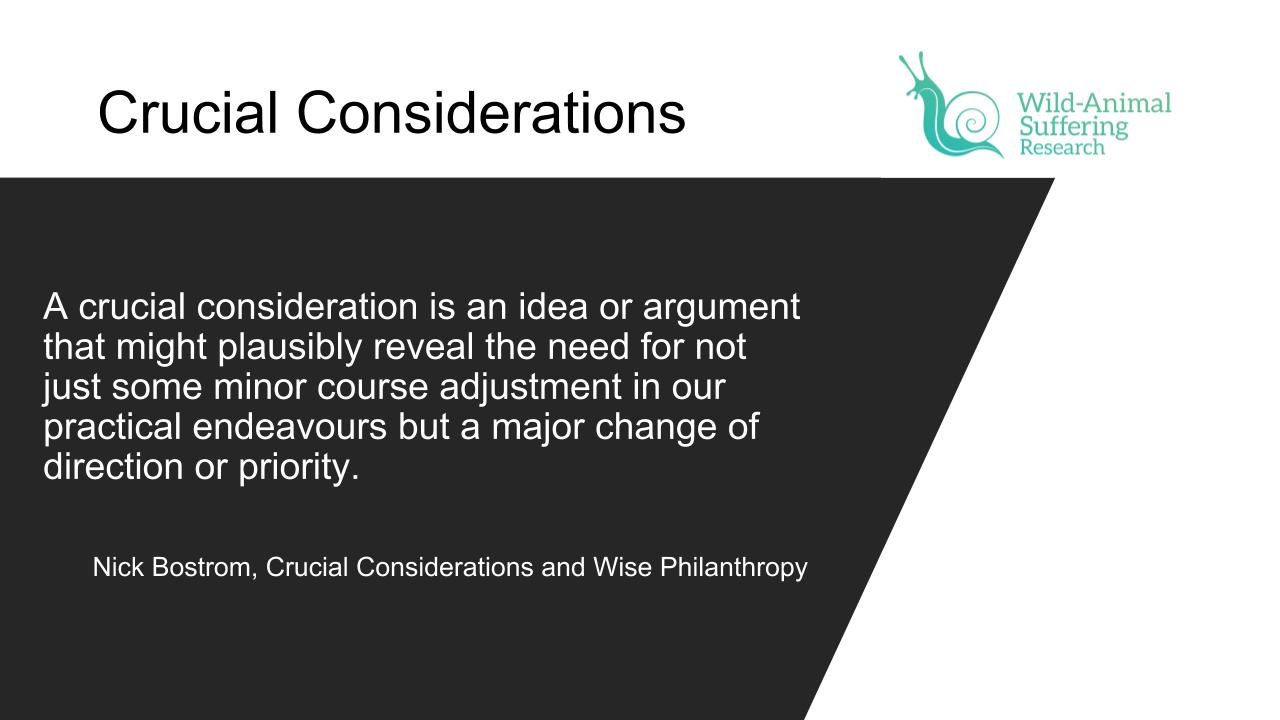
"Crucial consideration" is a term that Nick Bostrom created, and it's essentially an idea or argument that might plausibly reveal the need for not just some minor course adjustment in our practical endeavors, but a major change in direction or priority. We can break down practical endeavors into three components. We can look at our primary goal, our evaluation standard, and our focus area. So if our primary goal as EAs is to help others as effectively as possible, then we might define our evaluation standard as improving the quality of life or reducing the suffering of moral patients. And so the simple case we might make for wild animal suffering, is that suffering experiences in the wild are intense and frequent, and they affect an enormous number of beings. The majority of animals are short-lived and they experience many forms of prolonged chronic suffering like hunger, injury, parasitism, and disease. Reducing the suffering experiences of wild animals will improve the lives of a large percentage of moral patients. So, if we have cost-effective solutions, we should work on resolving the problem.
Now, an example of a crucial consideration here would be, "Well, what if wild animals can't suffer?" In that case, our interventions aren't adding any value and pursuing the goal would be pointless because we're not actually doing any good. One point before I move on, though, is that I think there is very strong evidence that many wild animals can suffer.
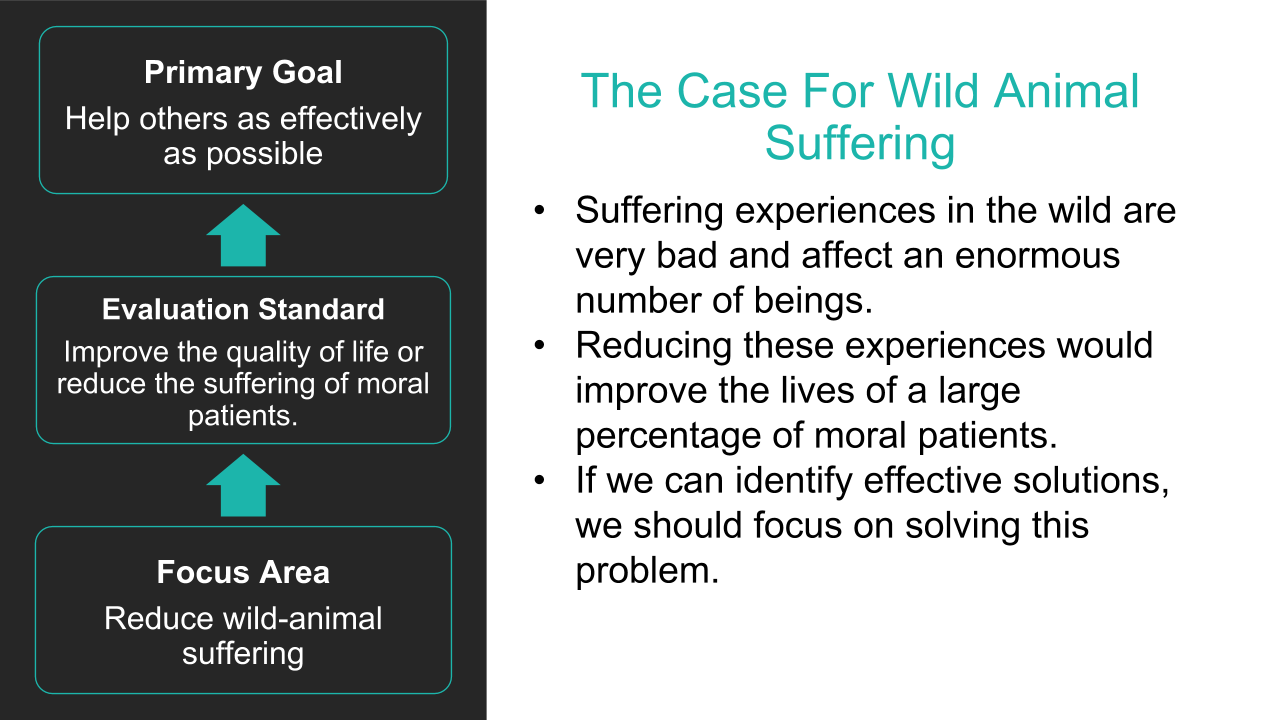
I defined the evaluation standard as improving the quality of life and reducing the suffering of moral patients. But what constitutes a moral patient depends on one's worldview. So here I'm using the categories of worldviews that the Open Philanthropy Project uses, just to maintain consistency in terminology. So we have a long-termist worldview which assigns very high value to the future; a near-termist, human-centric worldview, which assigns value to improving the lives of humans in a relatively shorter time frame; and then a near-termist, animal-inclusive view, which cares about improving the lives of humans and also gives significant moral weight to animals in a shorter time frame.

So clearly, from a near-termist, human-centric worldview, wild animals are not moral patients, and so if you subscribe to this view you wouldn't really prioritize wild animal suffering. Also, from a near-termist, animal-inclusive worldview, you would consider that at least some wild animals have the capacity to suffer and might be moral patients. And whether or not you prioritize wild animal suffering then depends on how cost-effective the cause area is.
So what's really interesting is the long-termist worldview. We usually, when we talk about a long-termist worldview, we talk about the enormous number of people who will exist in the long-term future. The basic argument is that because the number of people who could exist in the long-term future is so large, the long-term future dwarfs all near-term considerations, and so we focus our altruistic efforts on putting humans on a positive trajectory so that we have the capacity to reach our full potential. This view focuses largely on helping humans, and it's silent on whether it gives moral weight to nonhumans. It's not clear to me whether it's implicitly included, but since it could be a catastrophic oversight if we didn't include nonhuman moral patients, for those of us who subscribe to an inclusive worldview, what we might want to do is have this category called the long-termist, nonhuman-inclusive worldview. Which, very similar to the near-termist, animal-inclusive worldview, cares about ensuring that humans flourish, and also cares about ensuring that we improve the lives of nonhumans, should they exist.
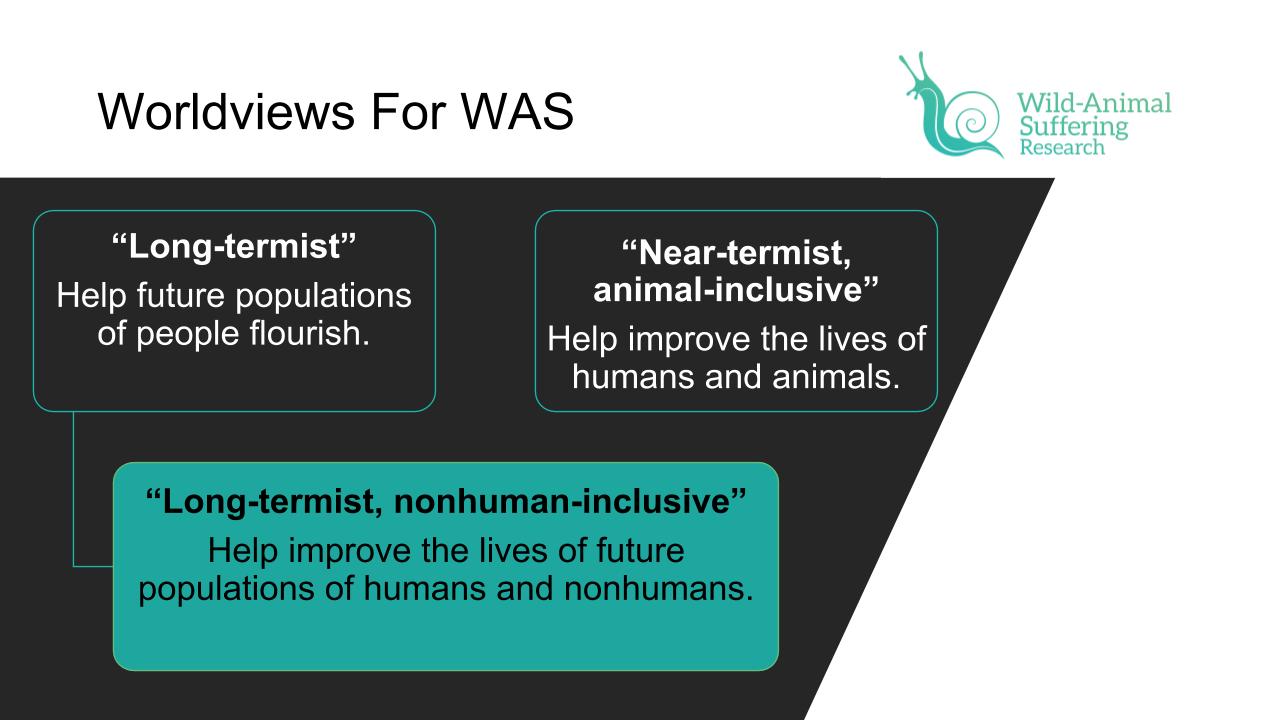
So what I'm going to do now is focus on the near-termist, animal-inclusive and the long-termist, nonhuman-inclusive worldviews, and look at some crucial considerations for both of these. Let's start with the near-termist. The strength of the case for why wild animal suffering is a priority from a near-termist view is the scale, and we can look at the scale of the problem using a few different measures. It's important that we do use a few different measures, because no single measure is perfectly accurate. So we can look at abundance, using farmed vertebrates as a reference point.
Near-termist, animal-inclusive view
 This chart is on a log scale, so each unit is one order of magnitude greater than the one before it. At any one point in time, we might have approximately 123 billion farmed vertebrates, and that includes fish. We have approximately 1 quadrillion wild vertebrates and approximately 1 sextillion invertebrates.
This chart is on a log scale, so each unit is one order of magnitude greater than the one before it. At any one point in time, we might have approximately 123 billion farmed vertebrates, and that includes fish. We have approximately 1 quadrillion wild vertebrates and approximately 1 sextillion invertebrates. Unfortunately, we have less data for biomass than we do for abundance. The data that we have for farmed vertebrates includes fish, so we have 0.1 gigatons of carbon, compared to 0.7 gigatons of carbon for wild vertebrates, and 1.72 gigatons of carbon for invertebrates. One thing to point out with this measure is that the wild vertebrate estimate includes fish, and the farmed vertebrate estimate doesn't include fish, and it's very likely that if we had a biomass estimate for farmed fish, the ratio would be much smaller between farmed vertebrates and wild vertebrates.
Unfortunately, we have less data for biomass than we do for abundance. The data that we have for farmed vertebrates includes fish, so we have 0.1 gigatons of carbon, compared to 0.7 gigatons of carbon for wild vertebrates, and 1.72 gigatons of carbon for invertebrates. One thing to point out with this measure is that the wild vertebrate estimate includes fish, and the farmed vertebrate estimate doesn't include fish, and it's very likely that if we had a biomass estimate for farmed fish, the ratio would be much smaller between farmed vertebrates and wild vertebrates.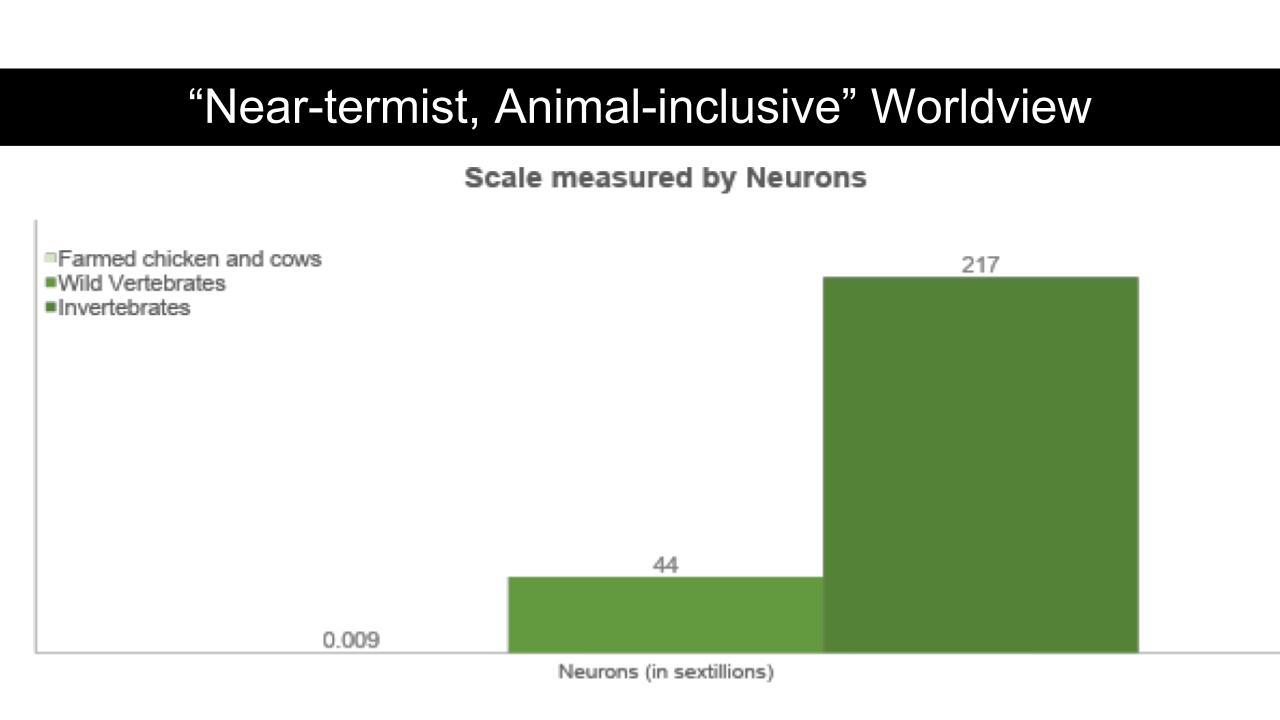 The next measure we might want to look at is neurons. For neurons, we have even less information. The information that we have for farmed vertebrates only covers chickens and cows, and we end up with 0.009 sextillion neurons combined. For wild vertebrates, we have 44 sextillion, and for invertebrates we have 217 sextillion. Another interesting point here is that the number of neurons for wild vertebrates is dominated by fish. So the absence of fish in our farmed vertebrate estimate also contributes to there being such a large ratio between farmed vertebrates and wild vertebrates.
The next measure we might want to look at is neurons. For neurons, we have even less information. The information that we have for farmed vertebrates only covers chickens and cows, and we end up with 0.009 sextillion neurons combined. For wild vertebrates, we have 44 sextillion, and for invertebrates we have 217 sextillion. Another interesting point here is that the number of neurons for wild vertebrates is dominated by fish. So the absence of fish in our farmed vertebrate estimate also contributes to there being such a large ratio between farmed vertebrates and wild vertebrates.The conclusion we might draw from these measures of scale is that when we talk about the problem, invertebrates dominate according to every measure. But there are a few caveats that we want to keep in mind. Firstly, the abundance comparisons between farmed vertebrates and wild vertebrates make an assumption that the lives of farmed vertebrates are equal to those of wild vertebrates. However, they don't take into account the comparison of the disutility between farmed lives and wild lives. Abundance measures also equate vertebrate lives with invertebrate lives, and that's very likely to be inaccurate. I'll discuss how we might want to work with the value of invertebrate lives a little bit further into the talk.
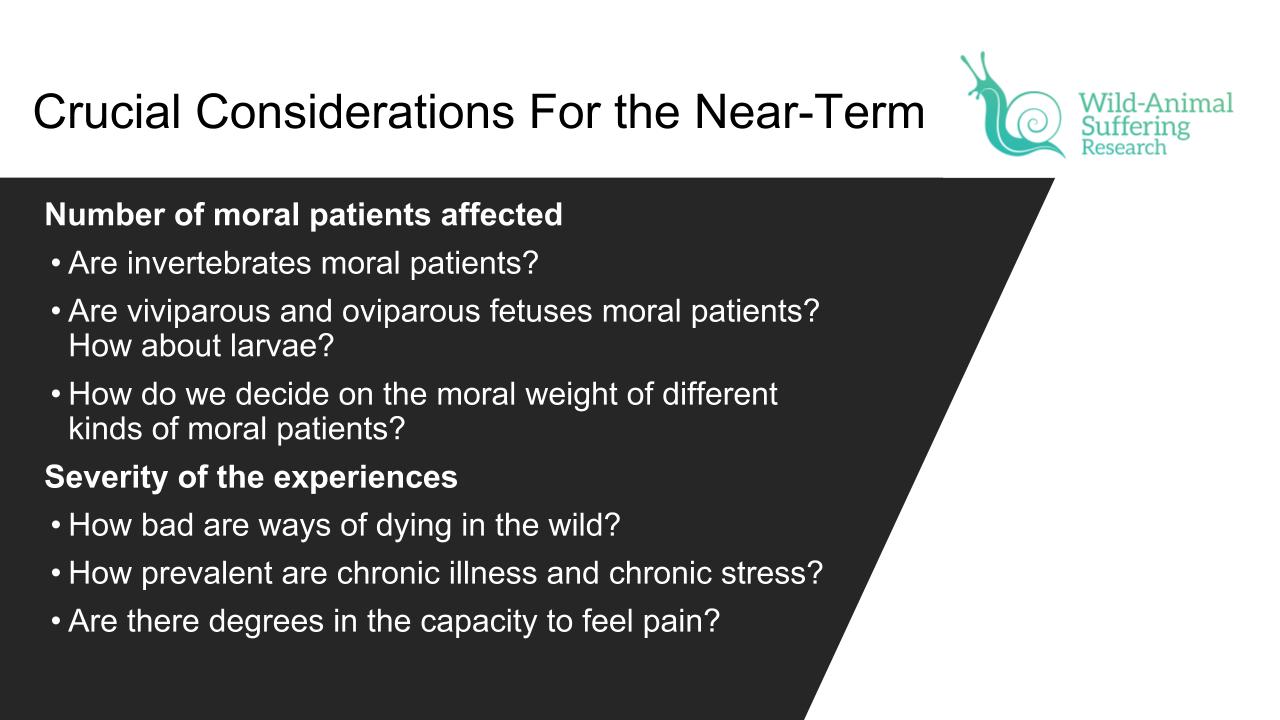
Because we have such a simplistic model when we think about the scale, we also want to think about what sorts of considerations might have a drastic effect on the expected value of our efforts. And we can break this down into two different categories: We can look at the number of moral patients affected, and the severity of their experiences. And so we need to ask questions like, are invertebrates moral patients? Are fetuses moral patients? What about larvae? How do we decide on the moral weight between different kinds of moral patients? That includes not just deciding between the moral weight of an ant versus a cow, but also an ant versus a nematode. We also need to consider the severity of various sorts of negative experiences. How bad are different ways of dying? How prevalent is chronic pain in the wild? And, are there degrees in the capacity to feel pain? I'm not going to try and answer any of these in this talk; these are each a talk in and of themselves. Instead what I'm going to do is choose the first one, “Are invertebrates moral patients”, and look at it in a little more detail.

If invertebrates aren't moral patients, then the scale of the problem is significantly reduced. When we exclude invertebrates, we see abundance drop from 10 orders of magnitude to 3, we see biomass drop from 17 times to 7 times larger, and neuron count drops from 5 to 4 orders of magnitude. When we combine these decreases with how uncertain the tractability of wild animal suffering is, then it might then be plausible that wild animal suffering is not the right focus area from a near-term, animal-inclusive perspective, and therefore that it's not a good candidate for our prioritization. But I think it's pretty unlikely that we can confidently say that invertebrates are not moral patients. There are a few reasons:
The first reason is that we don't have a clearly defined measure of moral patienthood. What we tend to do when we try and understand who constitutes a moral patient, is we look at features of humans. Since we consider ourselves moral patients, we extrapolate from our own features to see whether animals might share them. So we might look at subjective experiences: does an animal recognize itself in a mirror? We might look at cognitive complexity: do animals use tools, or do they have a complex language? Or we might look at an animal's ability to demonstrate pain-avoidance or pleasure-seeking behavior, and then try to understand: is their behavior mechanical or is it deliberate? Are there elements of learning involved?
The second reason why we can't really confidently say that invertebrates are not moral patients, is that experts reasonably disagree on whether invertebrates even fulfill that criterion. So there are some studies that demonstrate invertebrates expressing pain-avoidance behavior, and then there are others where invertebrates don't express that behavior. And so with this uncertainty, it's very potentially dangerous to ignore the potential moral patienthood of invertebrates, but we also can't confidently conclude that they are moral patients. So what can we do?

The first thing we can do is think about the precautionary principle, which just assumes invertebrates are moral patients, and then takes their interests into account in our actions. This makes sense in instances where we unnecessarily inflict potential suffering on invertebrates. For example, we could stop wearing silk, because the process of silk production involves boiling silk worms alive. Or we could advocate against the development of insect farms as an alternate source of animal-based protein. And that's not to say that we should support the existing farms, but that we might want to instead support plant-based protein, or clean meat. However, as a universal rule, the precautionary principle doesn't really work. It doesn't give us any guidance on how to weigh invertebrates relative to other moral patients. It doesn't give us guidance on how to weigh classes of invertebrates. And, it's not likely to always be cost-effective. And that means we could be wasting resources that are better applied elsewhere.
Another approach we might want to think about is expected value, and this should be very well understood by Effective Altrusits; we use this all the time. If we assume:
- P is the probability of invertebrates being moral patients,
- P multiplied by the number of invertebrates is greater than or equal to the number of known moral patients,
- invertebrates are moral patients, and
- they matter equally per individual as vertebrates,
then when we think only about invertebrates, wild animal suffering is on a greater scale than other focus areas in a "near-termist, animal-inclusive" worldview. So for example, we could assume that all humans and vertebrates are known moral patients. That would give us approximately ten trillion known moral patients. And so, if we give a probability of one in a million to invertebrates being moral patients, then the expected utility of helping invertebrates outweighs that of all other moral patients. However, there are two very clear followup questions here:
- How do you determine probability P?
- If we don't think invertebrates matter equally to vertebrates per individual, how much do they matter?
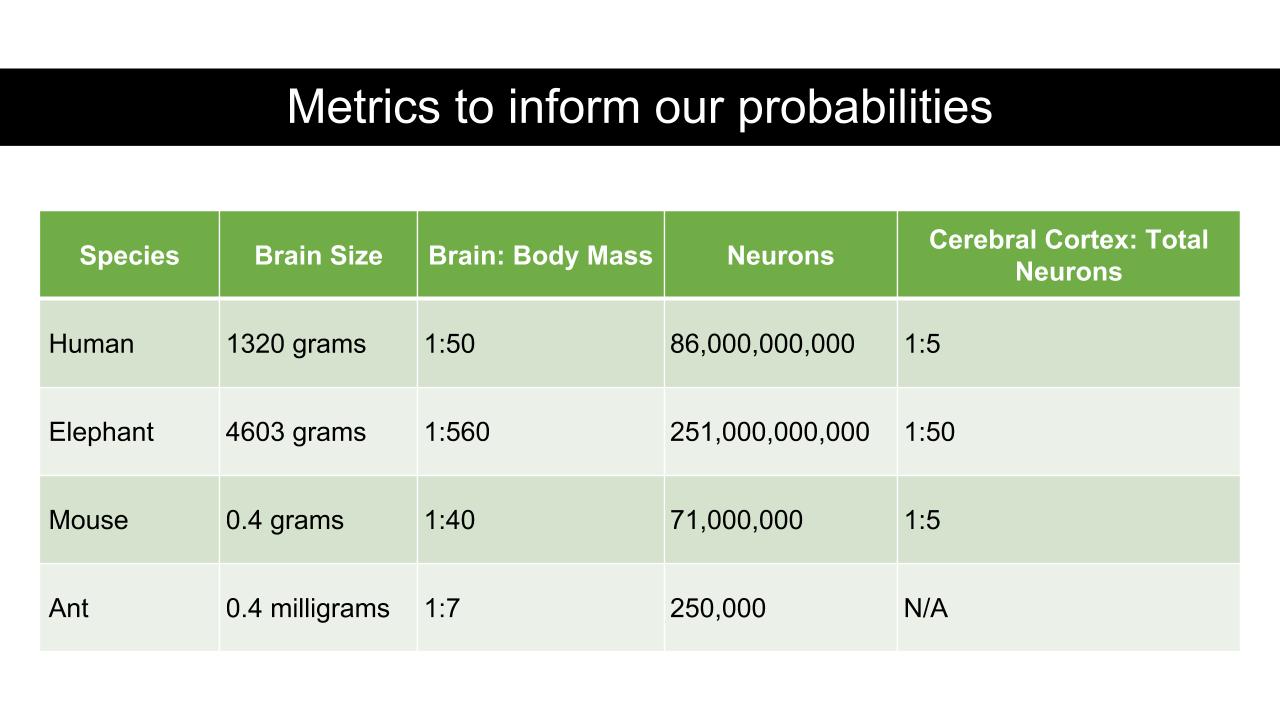
There are a few measures experts might use to try and understand how to answer these questions. We might look at things like absolute brain size, brain to body mass ratio, total neuron count, or the ratio of cerebral cortex neurons to total neuron count. When we look at brain size, the reason we might think, "Well, the size of a brain determines intelligence or cognitive complexity," is because the larger a brain size, the more cells it has, and the more energy is involved to develop more complex activities or more complex computations.
The problem with this approach is that an elephant has roughly a four times larger brain than humans, but we don't often consider elephants smarter than humans.
We could also look at the ratio of brain to body mass. Because the size of an elephant is so much larger than a human, a large percentage of neurons in an elephant brain are used on basic body functions, as opposed to more complex cognitive processes. Whereas for a human, we see a much smaller ratio of brain to body mass. But using ratios of brain to body mass, we run into trouble too: we have mice and ants, which have smaller ratios of brain to body mass than humans. In fact, smaller animals generally do have a smaller brain to body mass ratio than much larger animals.
So we might also want to look at total number of neurons, but again we see that when we just look at absolute size, it doesn't give us much guidance. Again, elephants have an absolute greater number of neurons than humans, which suggests they should be able to demonstrate more cognitive complexity than we do. One reason why they might not has to do with the structure and function of the brain. Some brain regions seem more important for cognitively complex tasks, so it may be better to measure these directly. In mammals, for example, most of our cognitively complex tasks are located in the cerebral cortex. And the cerebellum, by contrast, contains the neurons that focus on just keeping bodies functioning.
So finally, our approach is to compare the number of neurons in the cerebral cortex to the rest of the brain. Now we have this much more intuitive result, where an elephant has a ratio of one to fifty and a human has a ratio of one to five. Interestingly, we don't have results for an ant, because non-mammals don't have the same brain structure. So one problem we have with these measures is that they're not applicable across all species and across all taxa.
So, these sorts of measurement are basically what we have at hand to try and answer these questions. They're by no means perfect, and we lack a lot of data that we need to work on building before we have a very concrete way of answering the problem of weighing different sorts of animals as moral patients.
Long-termist, nonhuman-inclusive view
Next, let's look at the "long-termist, nonhuman-inclusive" view. What we're interested in is whether a focus on wild animal suffering increases the expected value of the future of humanity, and also the value of nonhumans that exist. Space colonization may mean that future humans export and multiply wild animal suffering into the universe, and therefore increase the scale of the problem. A related but more obscure problem is that advancements in artificial intelligence might lead to digital simulations of nature, and if those simulations contain moral patients, then that might also increase the problem.
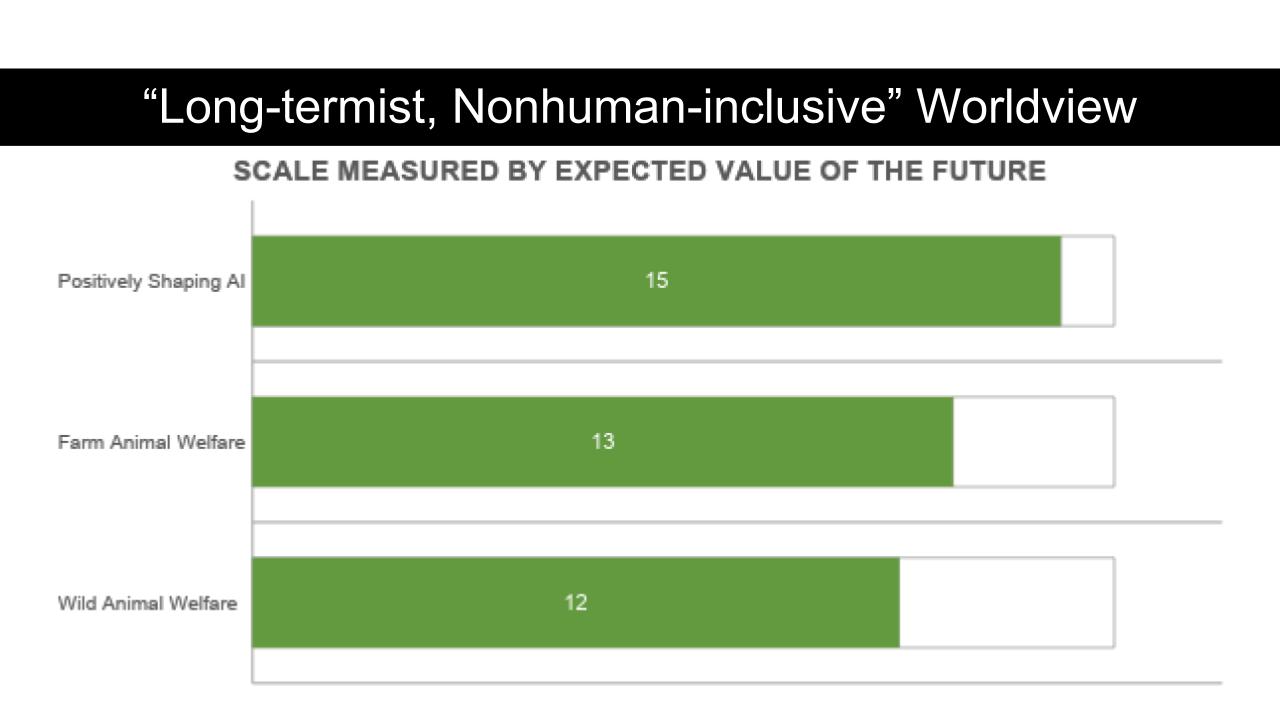
Long-term impacts of wild animal suffering are very difficult to measure, so what I've done here is taken the 80,000 hours quantitative framework, and extrapolated what I might score wild animal welfare. Note that this is very tentative and I don't encourage anyone to take this at face value. I'm using positively shaping AI as our reference point, and that gets a 15 out of 16 (this is on a log scale, where every two units equal an order of magnitude). Farm animal welfare scores a 13, and the reason is that more humane attitudes can increase the expected value of the future by between 0.1 and 1 percent. I think the same sort of reasoning applies to wild animal welfare. If efforts to reduce wild animal suffering will also increase humane attitudes, that might increase the expected value of the future, so wild animal welfare scores a 12. The reason I've given it 1 point less is because farm animal welfare is much more tractable. Through intense efforts in the present, we may be able to solve 10 to 90 percent of the problem. And it's not obvious to me that I can make an equally confident claim that we have the capacity through intense efforts to solve 10 to 90 percent of wild animal suffering. Therefore, I chose the lower bound for the scale.

On the long-termist view, there are several crucial considerations to consider:
- Is there more disvalue than value in nature?
- Do we expect future populations to care about nonhumans without our efforts?
- Relatedly, do we expect them to expand their moral circle without our efforts?
- Could space colonization spread wild animal suffering?
- Could advancements in artificial intelligence create digital moral patients?
- What population ethics do we subscribe to?
- More generally, how durable are value systems?

These are all massive questions, so let's just look at the first one: Is there more disvalue than value in nature? This question is really interesting to answer, because if there is more disvalue than value and flipping the sign is impossible or intractable, then we have two obligations. We want to prevent nature spreading beyond Earth, and we want to prevent artificial simulations of nature being created. But trying to answer this question is extremely difficult, and even when we try and break it down into sub-components, what we realize is that the sub-components are themselves crucial considerations. To list some of these related crucial considerations:
- Which nonhumans are moral patients?
- When we try and understand the ratio of disvalue to value in nature, who should we be including in our calculation?
- Again, how do we weigh different moral patients?
- How bad are negative experiences versus how good are positive experiences?
- Is it appropriate to use an expected value calculation to just aggregate across species? For example, if longer-lived mammals have net positive lives and shorter-lived, smaller mammals have net negative lives, even if we include a moral weighting, is it appropriate to just aggregate across all of them and say, "well, we think there is disvalue or value in nature?"
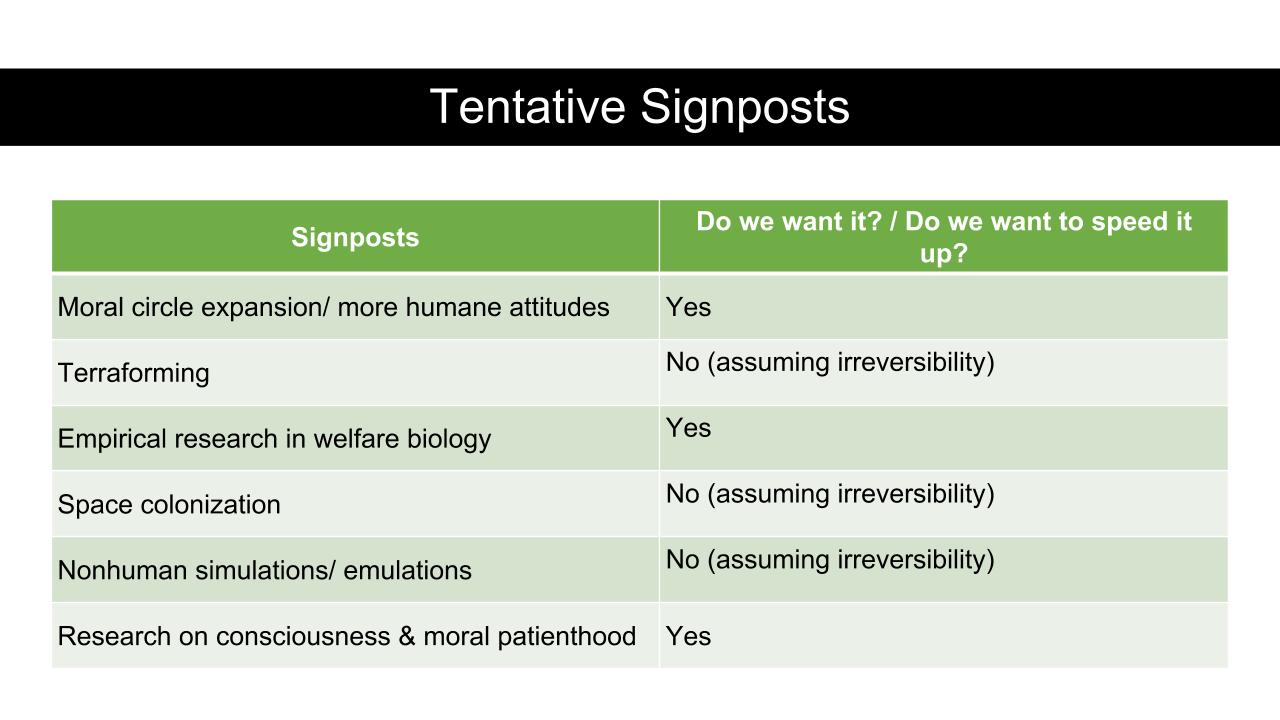
Nick Bostrom in his talk also covers a similar concern, the difficulty in trying to break down high level crucial considerations. To help with this challenge, he uses signposts, which are kind of like a concrete way to understand the direction we might want to be moving in. For, the signposts are pretty straightforward. We want to increase research because we want to improve the knowledge that we have. We want more humane attitudes because that makes it more likely that in the future humans will consider nonhumans morally. We might want to hold off on terraforming, space colonization, and nonhuman simulations and emulations, if they are irreversible. So if we create them, and we end up being unable to reverse them, and we're uncertain what the sign of that is, we could have potentially created an enormous amount of suffering unnecessarily.

Another approach we could take is to consider the moral value of information. This is based on a talk that Amanda Askell gave at EA Global last year. The basic idea if we have a belief about the effectiveness of an intervention with very little evidence, that belief has low resilience. And so where that's the case, assuming all else is equal, the value of new information is much higher. In our case, our belief in the net value or disvalue in nature is based on a very weak set of evidence, and so the resilience of this belief is low. If the resilience is low, then the expected values of actions that we take are not robust. We can't be confident in what the signs of our actions are. And so what this means, is it means we should invest in interventions that have a really high information value, conditional on their being relatively low cost to acquire. And comfortingly, I think this leads us to very similar conclusions as those we came to in the signpost, that we want to focus more on research, and that with more research we can increase humane attitudes.
Unfortunately, I have not left you with any answers in this talk, but if you found this really interesting and you're curious to learn more, or you're curious to figure out how you can contribute, the best advice I can give is to just learn, learn, and keep learning.
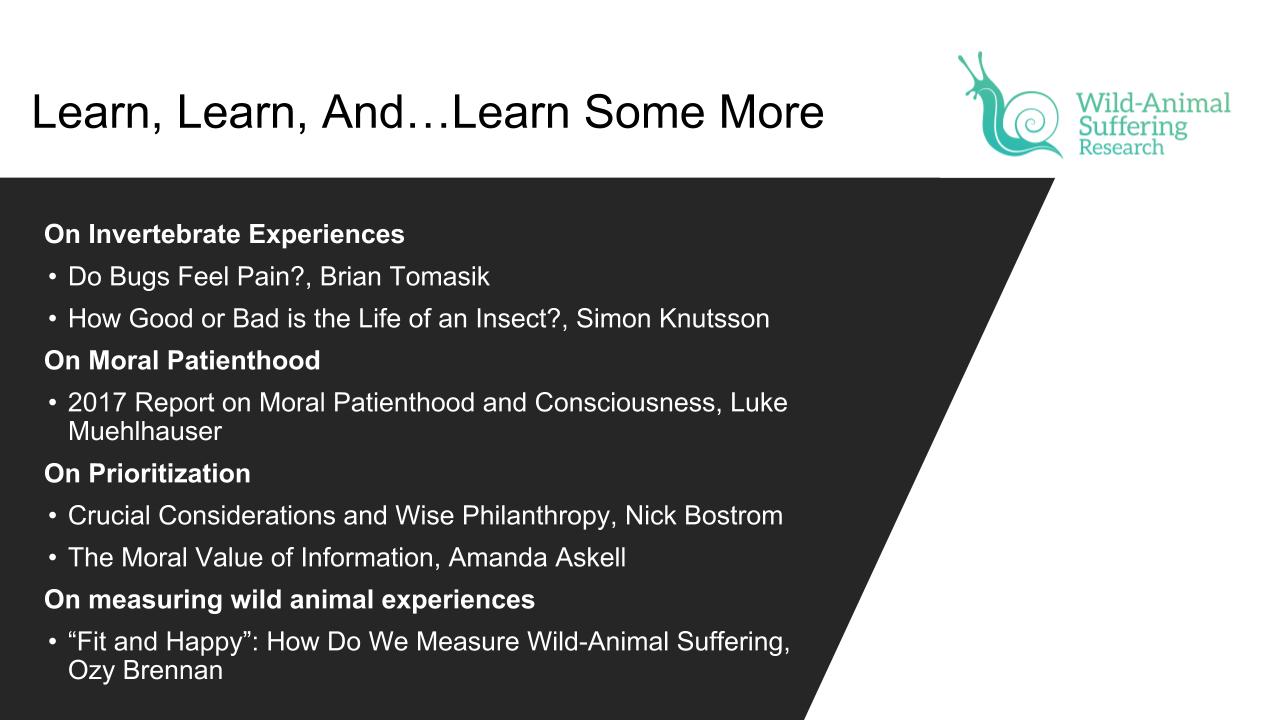
So, these are some texts that I found really, really useful. These are just a jumping off point though, so if you want more guidance, or you want to learn more and you've read all these, feel free to get in touch.
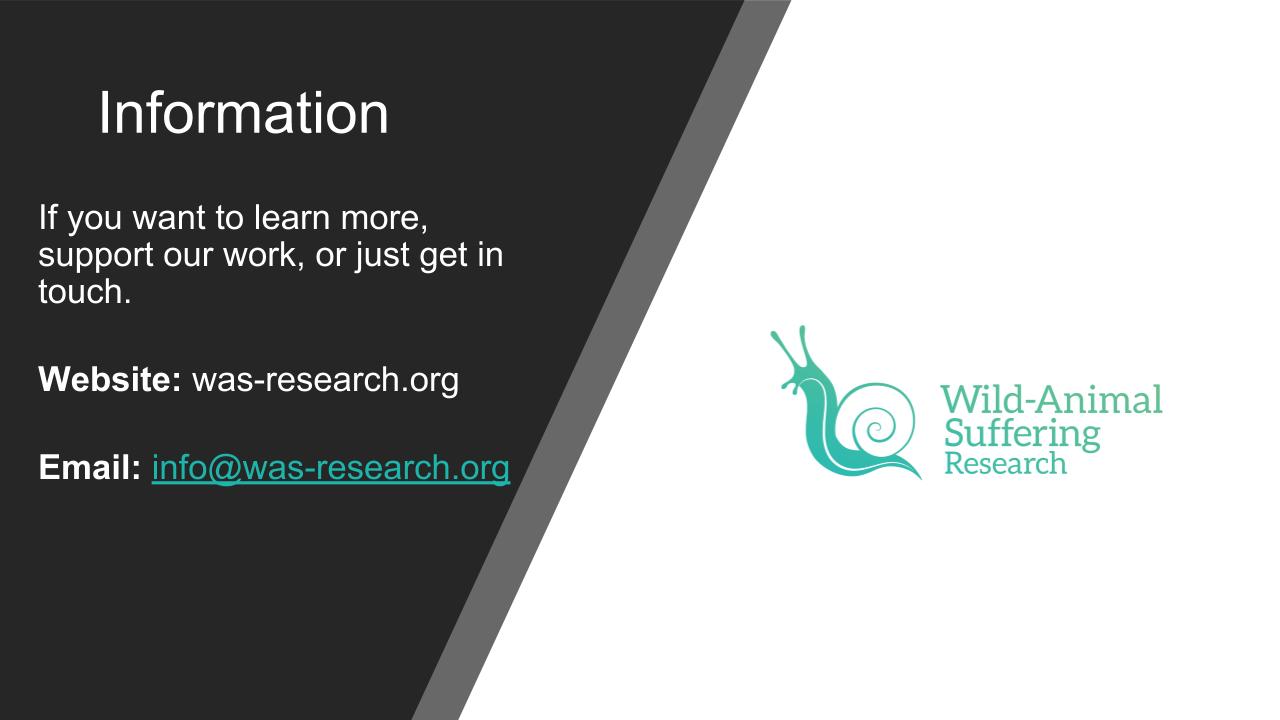
Questions
Question: I know I care about animals broadly, but how do I think about the distinction between wild and farmed?
Persis: I think the most important thing you'd want to think about is the severity of experience and the quality of lives. So if you're trying to understand whether you might want to prioritize farm animal welfare over wild animal welfare, for me the most important consideration is how much suffering is there in farmed animal welfare. And there's plausibly, throughout the duration of the life of a farm animal, more suffering than in the wild. The difference then, comes in the scale, which is that the number of wild animals is so much greater that maybe that outweighs farm animal welfare. But it's definitely not very clear. Another important thing to keep in mind is tractability. It's much more tractable to work on farm animal welfare than it is to work on wild animal suffering.
That's not to say that we shouldn't be working on wild animal suffering, but if you're interested in working on actionable interventions now, then farm animal welfare seems like the way to go. If you're interested in learning more about this potential other focus area, that could become one of the biggest near-term focus areas for us, then wild animal suffering seems like something that you'd be interested in supporting. But I would also encourage people to support both regardless. Because the main goal is to improve the welfare of all animals. And these are just two different problems that we've encountered.
Question: Why is biomass morally relevant?
Persis: There's very little information on brain size and neurons in animals, but body mass and brain size are positively correlated in that the larger a body, the larger the brain, and so when we don't have information on the brain size or the number of neurons, we might use biomass basically as a proxy for that. But in and of itself it doesn't really have moral value. The weight of the being doesn't have moral value, it's just that the larger a being – most likely – the larger the brain. And therefore, potentially, depending on how we weigh brain size in terms of moral patienthood, that could be morally relevant.
Question: For those who are interested in doing direct work or active research now in this subject matter, what advice would you give them?
Persis: It depends on your background. If you have a background in biology or ecology or neurobiology or any sort of domain expertise, then I would definitely encourage you to get in touch. We're hoping to create more opportunities for people with domain expertise to do some relevant research. I would also say, if you're based in academia, get to know supervisors within those departments and maybe try and sense how receptive they might be to different issues. In a lot of cases, even if they're not receptive specifically to wild animal welfare, they are just curious about answering these questions. And that might be sufficient to get more empirical information.
If you don't have domain expertise, then I would encourage volunteering and learning more about the sorts of outreach that we might want to do. Or perhaps the sort of advocacy that might be really useful on a broader scale, like anti-speciesism advocacy. That might be really useful, both for wild animal welfare and farm animal welfare.
Question: In terms of getting more information, where can people look and focus?
Persis: There's a lot of different places that I think are really useful. I mean, the first one, I think, is better understanding the physiology of invertebrates. It would be good to better understand the structures of their brains, and better understand the experiences that they have. That's really important to us, because the more information we have, the more guidance we have in terms of figuring out whether they are moral patients and how we should be acting towards them. It also seems useful to study large scale environmental and ecosystem changes, assessing them and the effects that they have on large populations. So looking at population composition, population dynamics. For example, one academic I'm talking to is looking at why 80% of ticks congregate on 20% of a population. That's really interesting, because if there are things that attract ticks or things that deter ticks, then maybe we can use that and genetically edit that into other species and minimize the prevalence of parasitism.
Another thing we could look at is the effect of climate change on population composition. Which populations survive and adapt really well, which are really resilient, which aren't, and what might be the reason behind that?
Question: Anything that at this point feels actionable, or is this all purely still in the research phase?
Persis: So there's a lot of things that are currently actionable. We currently do large scale wildlife contraception on overabundant populations. That's already happening and it's already being trialed in a number of different cities. So that's something that is definitely actionable. We've run large-scale vaccination programs in the past, not to benefit wild animals, to benefit humans, but it's also something that was successful and it's demonstrated that we can do it. We also do a lot of potential harm to invertebrates through the use of insecticides. We do the same thing with population control for overabundant vertebrate species, and there are ways we can try to minimize that. For example, we can use gene drives to reduce the populations of overabundant species, rather than killing them through population control measures. We could look for humane insecticides, or humane alternatives to existing insecticides for insects in agriculture. So there are a lot of things that are really actionable on a large scale, and even on a small scale, things like just being paying attention to invertebrates that are in your sphere of existence and making sure you're not causing them undue harm.